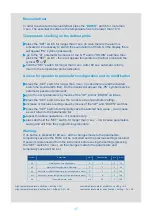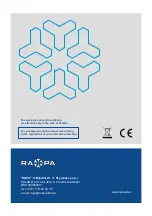
14
7. POSITIONING, START-UP AND OPERATION
To ensure proper operation, the device should be placed in an area with a good air circulation,
away from heat sources and sunlight, free from dust (the device is not dustproof), at ambient
temperature from +16°C to +25°C – 3
rd
climatic class. The manufacturer is not responsible
for interferences of the device operation in temperature beyond given range for 3
rd
climatic class.
Place the device horizontally and connect it to the power supply according to the guidelines
included in the chapter No. 4 -
“Wiring system”.
WARNING:
The device cannot be placed below the floor level (in a hollow).
The room in which the device is located must have a minimum cubature of 4 m
3
.The
sockets mounted on the device cannot be loaded with a current greater than 1.0 A
(230 W) in total - regardless of the number of sockets installed and the number of
connected receivers.
Start-up and exploitation:
The aggregate and lighting are switched on and off by means of the switches shown on picture
in the chapter No. 6. The temperature inside the device is adjusted by means of the electronic
temperature controller, according to the instructions included in the chapter No. 10.
After switching the device on, leave it empty until its switching off for the first time. After that it is
ready to be filled with products.
Maximum load that might be put in the middle of the worktop
– 20 kg.
Maximum load that might be put in the middle of the glass top
– 10 kg (the load has to be distributed
evenly on the whole Surface of the top).
Front glass panes has to be closed carefully, in the final closing phase, holding them in place
of the holders (indentations in the glass panes).
8. MAINTENANCE
After disconnecting the device from power supply, the general maintenance should be done
by the user, as follows:
1. washing with water of the temperature not more than +
40°C with addition of natural cleaning
agents.
To wash and clean the device it is forbidden to use agents containing of chlorine
and sodium of various varieties, which destroy the protective layer and components
of the device!
Any residual glue or silicone on the metal parts of the device should be removed
only with gasoline (not applicable to plastic components!). Do not use other organic solvents.
2. removing impurities from the condenser by means of vacuum cleaner
(from up to down -
along the fins)
at least once a month so that the flow of the cooling air through the condenser
fins is not hampered.
Not following the above instructions causes increased energy consumption, decreased
refrigeration efficiency of the device and eventually result in aggregate overheating,
which consequently may lead to failure.
While cleaning the condenser be careful not to deform the fins.
Do not wash the device
with a water jet.
It is not advisable to clean the condenser with a brush as it causes
impurities penetration deep into the condenser fins and finally block the air flow
completely.
For units with an automatic condensate evaporation system, clean the container every 2 weeks
to prevent the formation of unpleasant odours.
CLEAN THE CONDENSER WITH A VECUUM CLEANER HERE






































